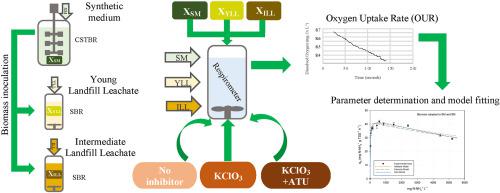Journal of Environmental Management ( IF 8.7 ) Pub Date : 2021-01-07 , DOI: 10.1016/j.jenvman.2020.111902 J.Joaquín González-Cortés , Fernando Almenglo , Martín Ramírez , Domingo Cantero

|
A widely employed approach to minimize the detrimental effect of landfill leachates (LL) on nitrifying biomass is to adapt it to these contaminated effluents prior to use. In the study reported here the impact of different intermediate landfill leachates (intermediate 1 (ILL1) and intermediate 2 (ILL2)) and synthetic medium (SM) on the nitritation rates of non-adapted and adapted nitrifying biomass were evaluated and modeled. The models, based on previously reported models (Haldane, Edwards and Aiba), considered the effect of three different heavy metals (Cu, Ni and Zn) present in both landfill leachates. The proposed models fitted well with the different biomasses. The highest specific substrate oxidation rate (qS) of the present study (41.85 ± 1.09 mg N–NH4+ g TSS−1 h−1) was obtained by the non-adapted biomass using SM. The non-adapted biomass was characterized by ~5- and ~28-fold higher nitritation rates on using the different ammonium sources tested (SM, ILL1 and ILL2) when compared to the other biomasses adapted to ILL1 (~9 mg N–NH4+ g TSS−1 h−1) and ILL2 (~1.3 mg N–NH4+ g TSS−1 h−1), respectively. The calculated inhibition constants indicate that the inhibitory effect of the heavy metals followed the order Ni>Zn>Cu. The results reported here bring into question the commonly accepted idea that an adaptation period of the biomass is required to treat landfill leachate.
中文翻译:

两种不同的中间垃圾渗滤液对未适应和适应硝化生物量铵氧化速率的影响
最大限度地减少垃圾渗滤液(LL)对硝化生物质的有害影响的广泛采用的方法是在使用前使其适应这些被污染的废水。在此报告的研究中,评估并模拟了不同的中间垃圾填埋场渗滤液(中间物质1(ILL1)和中间物质2(ILL2))和合成培养基(SM)对未适应和适应的硝化生物量硝化速率的影响。这些模型基于先前报道的模型(Haldane,Edwards和Aiba),考虑了两种垃圾渗滤液中存在的三种不同重金属(Cu,Ni和Zn)的影响。所提出的模型非常适合不同的生物量。本研究中最高的特定底物氧化速率(q S)(41.85±1.09 mg N–NH 4 + g TSS-1 h -1)是使用SM通过非适应性生物质获得的。与其他适应ILL1的生物质(〜9 mg N–NH 4)相比,使用不同铵盐源(SM,ILL1和ILL2)时,不适应的生物质的硝化速率高出约5倍和〜28倍。+ g TSS -1 h -1)和ILL2(〜1.3 mg N–NH 4 + g TSS -1 h -1)。计算得出的抑制常数表明,重金属的抑制作用遵循Ni> Zn> Cu的顺序。此处报道的结果使人们普遍接受的观念提出了质疑,即需要生物量的适应期来处理垃圾渗滤液。


























 京公网安备 11010802027423号
京公网安备 11010802027423号